Mon & Brec embankment - a potential threat to life
April 2018 - For the second time in four years Canal & River Trust is carrying out an emergency repair to the Llanfoist embankment on the Monmouthshire & Brecon Canal. The repair follows an application for an injunction requiring C&RT to remove the water from the canal above several properties threatened by inundation should the embankment fail. Allan Richards investigates a seemingly innocuous towpath closure notice.
C&RT's notice is for a towpath closure between 26 February and 19 May inclusive. It reads:
'The towpath between Bridge 97 (between Govilon and Llanfoist) and Bridge 95a (Tod's Bridge) will be closed from the 26th February until the 19th May 2018 due to embankment repair works.
Please use the alternative route we have provided. We apologise for any inconvenience this may cause.'
To understand what is going on we need to go back in history. The 'Mon and Brec' was originally two canals. The Monmouthshire Canal ran from Newport to Pontymoile. It included an arm to Crumlin.
The Brecknock and Abergavenny Canal ran from Pontymoile to Brecon. The history of abandonment and partial restoration is complex and does not concern us here. Suffice to say what we have today is about 35 miles of navigable canal, mainly the Brecknock and Abergavenny with much of the Monmouthshire unrestored.
A serious breach near Gilwern on 16 October 2007 confirmed that the 'Mon & Brec' is the most fragile of canals. The breach caused a number houses to be evacuated and long term closure of 16 miles of canal between Llanover and Llangynidr .
British Waterways findings were that they had identified 90 leaks in the area and that £15m needed to be spent to deal with them. As far as can be ascertained, BW only spent £8m.
A 2011 report by BW (and later C&RT) Operations Director, Vince Moran, provided to BW's board and C&RT Transition Trustees was obtained under the Freedom of Information Act. It makes stark reading, especially regarding the Mon & Brec's structural integrity-
3.2.1 The canal was constructed as a contour canal wrapping itself around the hillside. The materials of construction of the embankments and the underlying geology are poor which means the canal is prone to leakage and slips.
3.2.2 Half the canal (26km) is considered to be of higher geological and/or embankment risk. Of that length, 40% is now lined (10km with concrete or PVC) and a further 16% has been improved with clay and porcupine walls.
3.2.3 The instability of the canal bed reduces our ability to dredge leading to many boating customer complaints ...
3.2.4 The canal’s propensity to leak and then slip means that our focus has a much greater emphasis on reactive activity than the planned preventative maintenance found elsewhere. In addition, a specially designed electronic leak monitoring programme is in place to ensure that reactive works take place at optimum locations and at the right time. Risk management currently costs over £300k per annum comprising routine leak stopping by the waterway direct labour team (£100k materials and labour); consultancy costs for electronic leak monitoring over 4.45km of high risk embankment (£150k) and technical team support (£50k). There is a robust inspection and risk management regime in place and currently 297 known leaks are being monitored by inspection which includes flow measurement.
3.2.6 Relining of the canal would be required to make a significant difference to leakage. It would also provide the greatest assurance of structural stability and, therefore, reliability of the canal. Lining the remaining 16km of the high risk section of the canal would cost £20m and lining the whole of the canal would cost around £60m ...
A year later the embankment at Llanfoist started to slip above some properties. These included Llanfoist House, a grade II listed Georgian building. A repair was made by Kier using specialist contractor Condor Projects. The repair was made by grouting and using 500 (10-20 metre) soil pins to nail the embankment to the underlying bedrock with mesh covering and new vegetation planted. Condor Projects website reads'Given the extent of the slip and risk to a property some 100 feet down the bank from the towpath it was imperative to react quickly and mobilise accordingly'.
The slip was reported to what was by this time C&RT's board with photos showing 'the failure developing over a relatively short time'. Vince Moran told Trustees 'The canal in this area has a history of catastrophic failure' but added 'The engineering judgement was that the embankment was unlikely to collapse completely and would continue to slip slowly down the hillside. On the basis of this judgement, it was decided that evacuation of houses was unnecessary but that close and regular monitoring would take place until a repair solution was devised.'
The estimated repair cost was £1m but the final costs were in the order of £1.5m. Whilst there is no evidence to suggest that the repair was curtailed due to cost overrun the fact is that further repairs are now taking place.
C&RT's board were informed in January that Charles and Patricia Lester of Llanfoist House, both in their 70's, had applied for an injunction requiring the Trust to remove the water from the canal above their property, due to imminent risk of failure. The board were further informed 'Counsel advise that the Judge would be likely to find in favour of the Lester’s as the potential threat to life outweighs the financial and business impact of draining the canal; the canal would then be required to remain dry until the risk had been removed'.
According to C&RT, the new works will take place on the lower part of the slope, nailing a 20m wide section of the embankment immediately above Llanfoist House at a cost of around £500,000 (this includes C&RT's legal costs fighting the injunction). Bizarrely, Trustees were also informed 'We have yet to conclude whether we will seek a contribution to the works from the Lester’s.'
Based on solicitors' advice, the Lesters have declined to comment for the time being. They may make a statement at a future date.
Both Welsh Government and the public at large seem oblivious to the parlous state of the 'Mon & Brec'. Despite a pressing need to spend large sums of money to bring the Mon & Brec into a sustainable condition without constant leaks and slips, the Trust has floated plans for spending £65m restoring disused parts of the canal (Plan to reopen Monmouthshire and Brecon canal to boats - BBC News).
The difference is, of course, that the majority of funds for restoration of unnavigable parts of the 'Mon & Brec' would not come from C&RT.
Will sanity will be restored following C&RT's reorganisation which will see the replacement of Andrew Stumpf, head of the Canal and River Trust in Wales (bet you have never heard of him) and Waterway Manager, Nick Worthington? Somehow, one doubts this.
It is a sad reflection on Canal & River Trust that court action is seen as the only way to remove a potential threat to life. For those of limited financial means, even this option is not available.
Photos: (1st) The Llanfoist slip, (2nd) Condor Projects working on the 2014 slip, (3rd) The 2014 failure developed over a relatively short time, (4th) Llanfoist House - the canal poses a potential threat to life argue the owners, (5th) Vince Moran - estimated that lining the canal would cost £60m.










